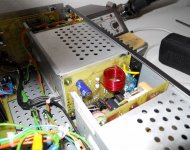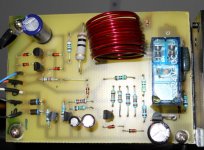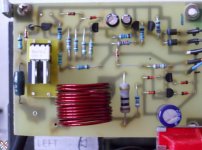A few years ago, someone in Europe was selling a relay designed for power amp outputs. It had two sets of contacts. The first was a normal beefy set of power contacts. The second were gold-plated contacts. Mechanically it would close the 'grunt' contact first and open it last. The good contacts would close second and open first.
Look at the top post:
Blog – S-AUDIO
A few years ago, someone in Europe was selling a relay designed for power amp outputs. It had two sets of contacts. The first was a normal beefy set of power contacts. The second were gold-plated contacts. Mechanically it would close the 'grunt' contact first and open it last. The good contacts would close second and open first. That way they were protected from arcing and pitting, yielding, according to the advertising, an 'ideal' and long-lived speaker relay.
One could do essentially the same thing with two properly-chosen relays and appropriate circuitry to drive them.
edit: Found the relay: it was (is?) made by Amplimo; don't know if it still is around. And the contacts were Tungsten (grunt) and Silver (good)
Another way to solve the arcing/pitting issue is to use Hg wetted relays. I know some are still available, but getting harder to find...
Another way to solve the arcing/pitting issue is to use Hg wetted relays. I know some are still available, but getting harder to find...
I prefer that Europeans and other non-United Statesians are able to build my circuits. The use of mercury wetted switches is not likely to be welcomed in many places. 🙂
That said, if you want good bounce behaviour, mercury wetted switches are fantastic. I built a TLP generator using some Hg relays "back in the day" (probably 15 years ago). The relays were a bit challenging to get even then.
Tom
If he has data to indicate that the relays cause no additional distortion even at the <-125 dBc level, I'm all ears. Talk is cheap. Data rule. Sorry if that rubs anyone the wrong way. It's how I roll.
Do you recall which solid-state relay you used for speaker switching duty?
They're a known trouble spot, yes. I recall conversations with the test engineers at National/TI about that, actually.
Tom
They were of the 'Finder' brand which seems a recognised name. I had them as two 8 amp contacts wired in parallel.
https://www.rapidonline.com/finder-40-52-9-024-0000-pcb-mount-relay-24vdc-8a-dpdt-agni-51-0514
My experiences show the opposite.Hmm, I don't recall any commercial amp I have used over the past 30 years had output protection. ...........
The vast majority of commercial power amplifiers and integrated amplifiers had some form of protection.
My experiences show the opposite.
The vast majority of commercial power amplifiers and integrated amplifiers had some form of protection.
I have not used any integrated amps. I am sure there are lots of amps that have some form of protection, but the more into purists designs, the less likely they do it. One amp I got had a delayed relay on the power supply due to the large inrush current (yes, the lights would dim upon power up), when I suggested a different solution, the too the relay out.
Sent from my iPhone using Tapatalk
If all you have ever used is poorly designed boutique equipment you will not have a good understanding of engineering best practice!
They were of the 'Finder' brand which seems a recognised name. I had them as two 8 amp contacts wired in parallel.
https://www.rapidonline.com/finder-40-52-9-024-0000-pcb-mount-relay-24vdc-8a-dpdt-agni-51-0514
Those are not solid state relays, but are they the ones mentioned here?
http://www.s-audio.com/?page_id=341
Sent from my iPhone using Tapatalk
If all you have ever used is poorly designed boutique equipment you will not have a good understanding of engineering best practice!
Actually I try to get best value in terms of fidelity. High cost or high specs do not guarantee that, but offer some guidance, they do have different trade off criteria.
Sent from my iPhone using Tapatalk
Those are not solid state relays, but are they the ones mentioned here?
Blog – S-AUDIO
Sent from my iPhone using Tapatalk
Those look quite fancy although of the same basic outline and footprint.
I made my solid state relays to be a direct drop in replacement.
Attachments
Looks interesting, do you actually hear a difference between the two? I see power supply solid state relays around, but feel kind of doubt using solid state relays in the signal path since the signal path adds active components which may not be optimized for high current signals.
Sent from my iPhone using Tapatalk
Sent from my iPhone using Tapatalk
Solid state relays for mains switching duty are invariably triac based and totally unsuited to audio signals such as speaker feeds.
The two back to back FET's that make up a relay such as the one I showed above have a low Rds, typically just 4.5mΩ per FET for the IRF2907's used. The big advantage now is that the performance will be the same 5 months, 5 years or 50 years down the line. The mechanical relay just can not compete with that.
Do I hear a difference ? Hard to say because it was initially hearing the gross distortion on a low level sine that prompted all this. All I can say is that I am happy in the knowledge that that problem (and any doubts over it affecting low level detail on music) are removed.
And how many times do we read on the forums of switches (and relays) being treated with Deoxit and similar because of very audible issues that the old contacts are causing. I would never go back to those days now.
The two back to back FET's that make up a relay such as the one I showed above have a low Rds, typically just 4.5mΩ per FET for the IRF2907's used. The big advantage now is that the performance will be the same 5 months, 5 years or 50 years down the line. The mechanical relay just can not compete with that.
Do I hear a difference ? Hard to say because it was initially hearing the gross distortion on a low level sine that prompted all this. All I can say is that I am happy in the knowledge that that problem (and any doubts over it affecting low level detail on music) are removed.
And how many times do we read on the forums of switches (and relays) being treated with Deoxit and similar because of very audible issues that the old contacts are causing. I would never go back to those days now.
Would be an interesting comparison. How can I get my hands on these to try out? I would probably try in one channel of a MyRef amp first. Probably later work it into my Mod built. Generally I test one channel for audibility effects before I go into detailed measurements.
Sent from my iPhone using Tapatalk
Sent from my iPhone using Tapatalk
You make them 🙂
This is a long thread and this just dives in at the middle:
http://www.diyaudio.com/forums/solid-state/191449-output-relays.html#post2659578
This is a long thread and this just dives in at the middle:
http://www.diyaudio.com/forums/solid-state/191449-output-relays.html#post2659578
You make them 🙂
This is a long thread and this just dives in at the middle:
http://www.diyaudio.com/forums/solid-state/191449-output-relays.html#post2659578
Thanks!
Sent from my iPhone using Tapatalk
Hi Tom,
No worries, we're perfectly fine.
I have heard of using mosfets as speaker relays and hope to test one soon that JeffW has designed. If there isn't any distortion increase, I'll recommend it. But before testing, I can't do that. I'll be looking at a very low distortion amplifier driving my dummy loads and try both types.
The reason why we hear about bad relay contacts is because the products using them are typically 20 years old or more, or they have just had an output stage failure that also damaged the relay. With good contacts, I strongly doubt they cause much in the way of distortion. If that were the case, every connection in the audio path, including all the internal connections in an amplifier, would be as bad as a relay. That would be an ugly situation!
Simple ways to deal with relay health. Turn the volume up only after the relay engages, and down before to switch off. I just serviced an amplifier that was over 30 years old and had a filthy, but perfect set of relay contacts. I had expected to have to replace the relay. That unit was a Teac BX-500 integrated amplifier used on another tech`s test bench.
The mosfet output protection board is something I am really looking forward to testing. I`m hoping it lives up to what I`ve heard about it.
-Chris
No worries, we're perfectly fine.
I have heard of using mosfets as speaker relays and hope to test one soon that JeffW has designed. If there isn't any distortion increase, I'll recommend it. But before testing, I can't do that. I'll be looking at a very low distortion amplifier driving my dummy loads and try both types.
The reason why we hear about bad relay contacts is because the products using them are typically 20 years old or more, or they have just had an output stage failure that also damaged the relay. With good contacts, I strongly doubt they cause much in the way of distortion. If that were the case, every connection in the audio path, including all the internal connections in an amplifier, would be as bad as a relay. That would be an ugly situation!
Simple ways to deal with relay health. Turn the volume up only after the relay engages, and down before to switch off. I just serviced an amplifier that was over 30 years old and had a filthy, but perfect set of relay contacts. I had expected to have to replace the relay. That unit was a Teac BX-500 integrated amplifier used on another tech`s test bench.
The mosfet output protection board is something I am really looking forward to testing. I`m hoping it lives up to what I`ve heard about it.
-Chris
If he has data to indicate that the relays cause no additional distortion even at the <-125 dBc level, I'm all ears. Talk is cheap. Data rule. Sorry if that rubs anyone the wrong way. It's how I roll.
Tom
I am wondering, if the relay is in the return path of the output, wouldn't amplifier distortion depend on where you pick off the reference ground when you measure amplifier performance?
Sent from my iPhone using Tapatalk
I made my solid state relays to be a direct drop in replacement.
Who's the li'l DIP-8 MOSFET driver dressed in white? Does he have a name or a part number?
Tom
http://www.diyaudio.com/forums/solid-state/191449-output-relays-3.html#post2618977
Seems like a photo coupler
Seems like a photo coupler
Last edited:
- Home
- Amplifiers
- Chip Amps
- Modulus-86 build thread


